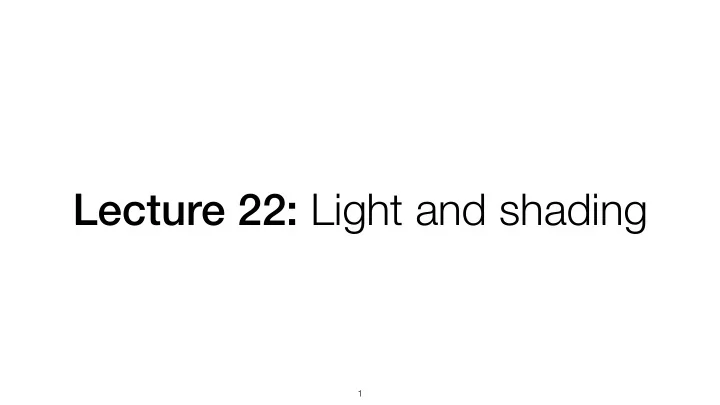

Lecture 22: Light and shading 1
Announcements • PS10 out • 2nd-to-last lecture on low-level vision. • Rest of course: recent vision topics.
Many interpretations of color! 3
The Workshop Metaphor 4 Source: J. Barron
The Workshop Metaphor 5 Source: J. Barron
The Workshop Metaphor 6 Source: J. Barron
The Workshop Metaphor 7 Source: J. Barron
The Workshop Metaphor 8 Source: J. Barron
Today • Light and surfaces • Shape from shading • Photometric stereo • Intrinsic image decomposition
Recall: interaction of light and surfaces Spectral radiance: power in a specified direction, per unit area, per unit solid angle, per unit wavelength. Spectral irradiance: incident power per unit area, per unit wavelength [Horn, 1986] 10 Source: W. Freeman
For now, ignore specular reflection Source: Photometric Methods for 3D Modeling, Matsushita, Wilburn, Ben-Ezra. Changes by N. Snavely 11
And Refraction… Source: Photometric Methods for 3D Modeling, Matsushita, Wilburn, Ben-Ezra. Changes by N. Snavely 12
And Interreflections… 13 Source: Photometric Methods for 3D Modeling, Matsushita, Wilburn, Ben-Ezra. Changes by N. Snavely
Recall: e ff ect of BRDF on sphere rendering Diffuse/Lambertian reflection 14 https://marmoset.co/posts/physically-based-rendering-and-you-can-too/ Source: W. Freeman
Di ff use reflection Diffuse reflection • Dull, matte surfaces like chalk or latex paint • Microfacets scatter incoming light randomly • Effect is that light is reflected equally in all directions Source: S. Lazebnik and K. Bala 15
Directional lighting • All rays are parallel • Equivalent to an infinitely distant point source 16 Source: N. Snavely
Di ff use reflection image intensity of P Simplifying assumptions we’ll often make: • I = R e : “camera response function” is the identity – can always achieve this in practice by inverting it • R i = 1: light source intensity is 1 – can achieve this by dividing each pixel in the image by R i 17 Source: N. Snavely
Other BRDFs Ideal diffuse (Lambertian) Ideal specular Directional diffuse 18
Non-smooth-surfaced materials 19 from Steve Marschner
Shape from shading Assume is 1 for now. What can we measure from one image? • is the angle between N and L • Add assumptions: • Constant albedo • A few known normals (e.g. silhouettes) • Smoothness of normals In practice, SFS doesn’t work very well: assumptions are too restrictive, too much ambiguity in nontrivial scenes. 20 Source: N. Snavely
An ambiguity that artists exploit! 21 [Belhumeur et al. “The Bas-Relief Ambiguity”, 1999]
Contours provide extra shape information Consider points on the occluding contour : N z = 0 N z positive N z negative Image Projection direction ( z ) 22 P . Nillius and J.-O. Eklundh, “Automatic estimation of the projected light source direction,” CVPR 2001 Source: S. Lazebnik
Application: finding the direction of the light source I ( x,y ) = N ( x,y ) · S ( x,y ) Full 3D case: N S For points on the occluding contour , N z = 0: 23 P . Nillius and J.-O. Eklundh, “Automatic estimation of the projected light source direction,” CVPR 2001 Source: S. Lazebnik
Finding the direction of the light source 24 P . Nillius and J.-O. Eklundh, “Automatic estimation of the projected light source direction,” CVPR 2001 Source: S. Lazebnik
Application: Detecting composite photos Real photo Fake photo [Johnson and Farid, 2005] 25 Source: S. Lazebnik
Photometric stereo 26 Source: N. Snavely
Photometric stereo N L 3 L 2 L 1 V Can write this as a linear system, and solve: 27 Source: N. Snavely
Photometric Stereo Input … Recovered Recovered surface model albedo Recovered normal field x y z 28 Source: Forsyth & Ponce, S. Lazebnik
Photometric Stereo Input Normals (RGB Normals (vectors) Shaded 3D Textured 3D (1 of 12) colormap) rendering rendering 29 Source: N. Snavely
Video photometric stereo Video Normals from Colored Lights Gabriel J. Brostow, Carlos Hernández, George Vogiatzis, Björn Stenger, Roberto Cipolla IEEE TPAMI, Vol. 33, No. 10, pages 2104-2114, October 2011. 30 Source: N. Snavely
But what if we don’t know the BRDF? [Johnson and Adelson, 2009] 31 Source: N. Snavely
32
33
34
35
36
37
38
What about paint? is reflectance or albedo 39
Intrinsic image decomposition Far Near S ( Z, L ) Z L shape / depth log-shading image of Z and L illumination R I = R + S ( Z, L ) log-reflectance Lambertian reflectance 40 Source: J. Barron
Intrinsic image decomposition Far ? ? ? Near S ( Z, L ) Z L shape / depth log-shading image of Z and L illumination ? R I = R + S ( Z, L ) log-reflectance Lambertian reflectance 41 Source: J. Barron
Intrinsic image decomposition Reflectance Shading 42
CNN-based reflectance estimation Input Reflectance Shading [Bell et al., “Intrinsic images in the wild”, 2014] 43
Applications of intrinsic image decomposition 44 [Barron and Malik “SIRFS”, 2012]
Application: relighting 45 [Barron and Malik “Scene-SIRFS”, 2013]
Application: relighting 46 [Barron and Malik “Scene-SIRFS”, 2013]
Next week: perceptual grouping 47
Recommend
More recommend